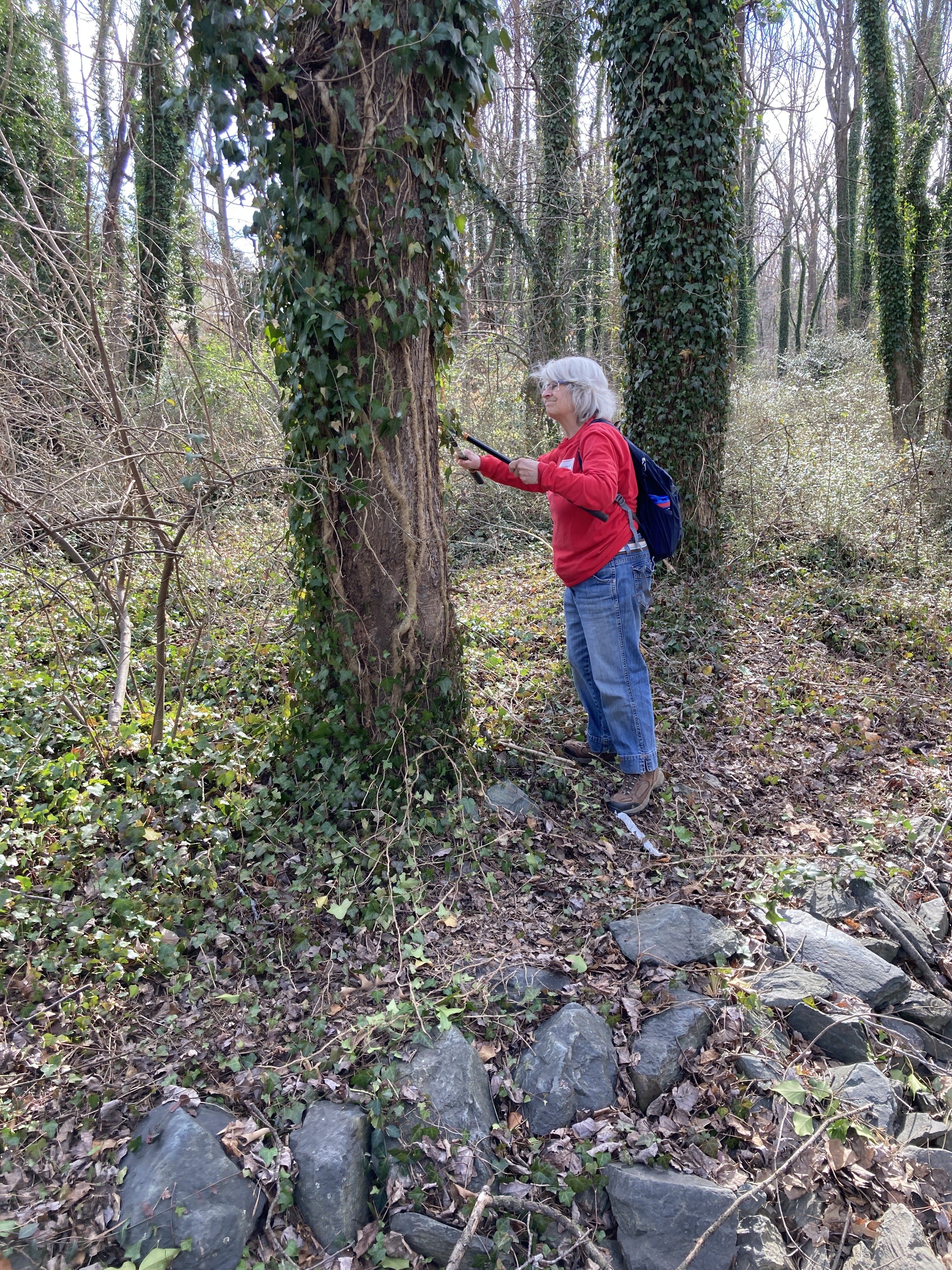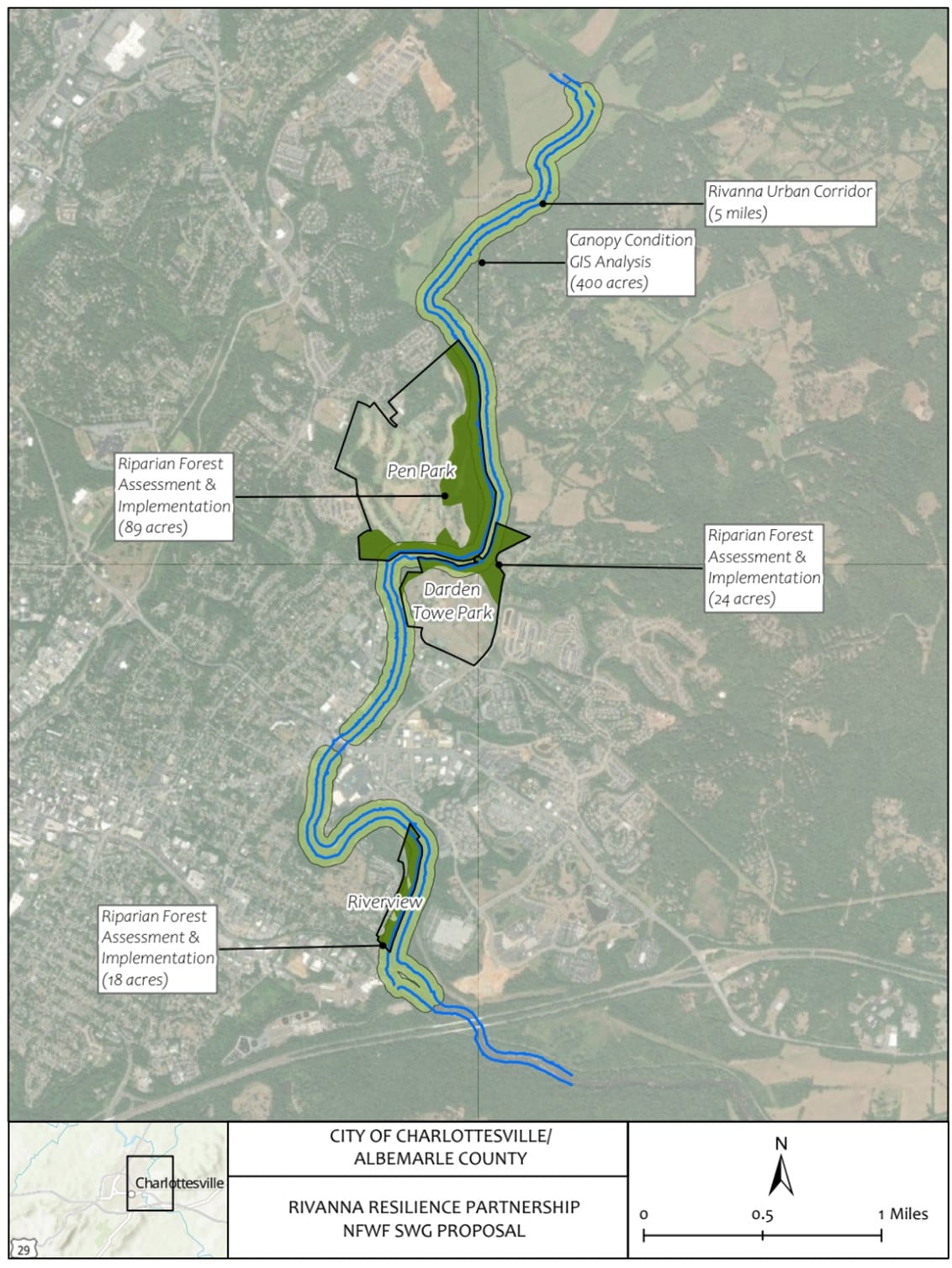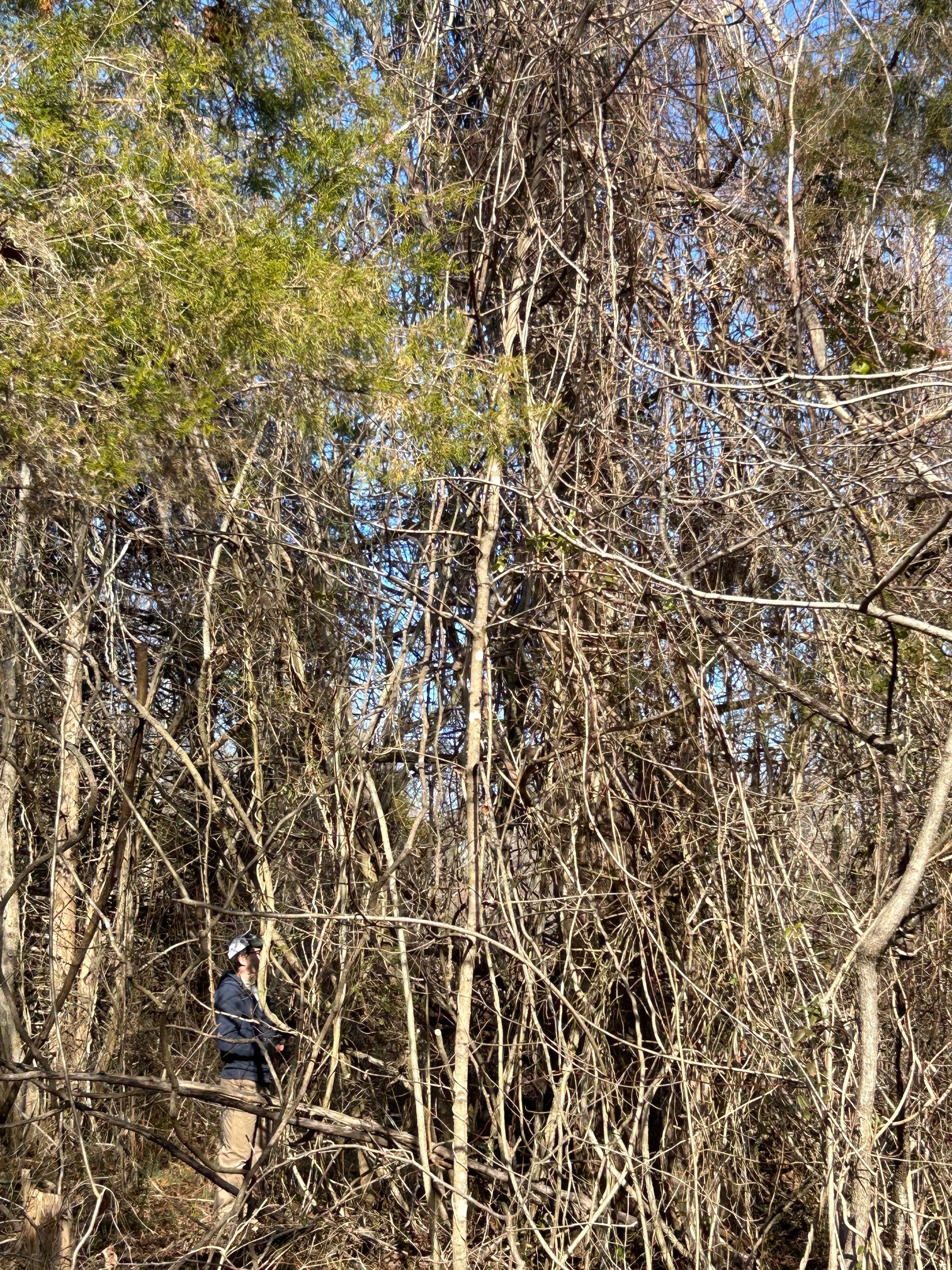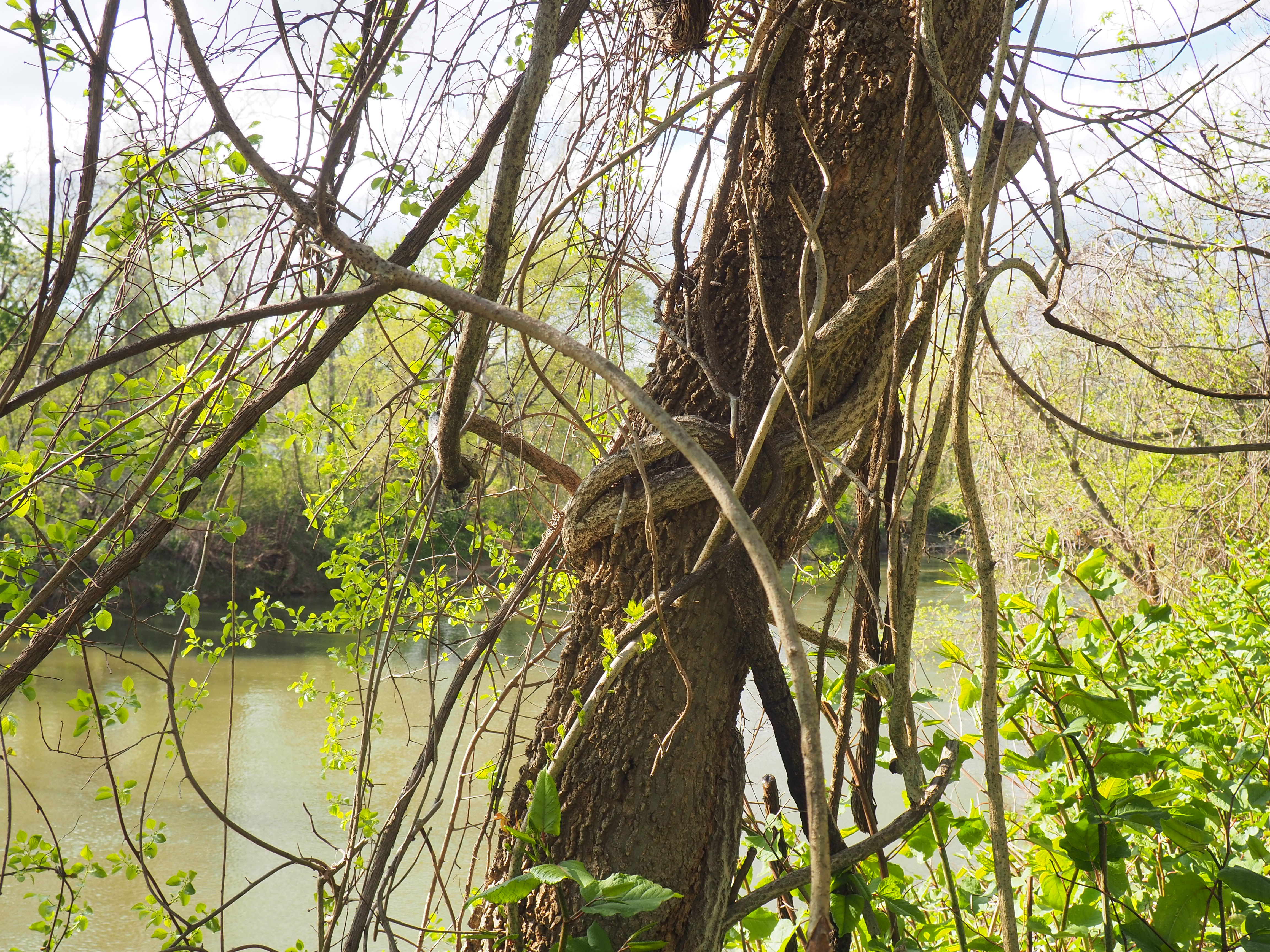Have you ever noticed a tree or an entire forest smothered in vines and wondered what is going on?

English ivy is one of the species this project will be working to control. English ivy easily escapes yards and infests natural areas.
What you are seeing is the ever-growing problem of non-native invasive plants. Due to their aggressive growth and lack of natural controls, these plants are a serious threat to the health and resilience of our native forests. They also imperil the important environmental and public health benefits forests provide. This is especially true for riparian forests that grow alongside waterways and play an essential role in protecting water quality and stream health.
In recent years, many organizations, local governments, and community members in the Charlottesville area have begun to take action to control invasive plants, largely through volunteer workdays. It has quickly become clear, though, that current efforts are greatly outscaled by the enormity of the problem and the lack of clear priorities and a coordinated approach.
To help address this issue more strategically and on a larger scale, more than a dozen nonprofit organizations, local government agencies, technical experts, and other community stakeholders, are forming a partnership and beginning to work together through a project called the Rivanna River Forest Health and Resilience Project.
What are invasive plants? According to the Virginia Department of Conservation and Recreation, invasive plants are species that are intentionally or accidentally introduced by human activity into a region in which they did not evolve and cause harm to natural resources, economic activity or humans.
Project Overview
The Rivanna River Forest Health and Resilience Project is funded primarily by a grant from the National Fish and Wildlife Foundation. It is a multifaceted project with the goal of improving forest health along the urban Rivanna River through the management of high-risk invasive plants and the planting of new native trees. It is a collaborative and coordinated effort to make on-the-ground improvements in forest health, and to motivate and support the wider Rivanna River watershed community to take action on these issues.
along the urban Rivanna River through the management of high-risk invasive plants and the planting of new native trees. It is a collaborative and coordinated effort to make on-the-ground improvements in forest health, and to motivate and support the wider Rivanna River watershed community to take action on these issues.
The project focuses on the five-mile urban corridor of the Rivanna River, from the confluence of the North and South Forks of the Rivanna down to Moores Creek. It includes activities at two scales:
- Broad scale mapping, outreach and engagement with riverfront property owners, with coordination taking place along the entire five-mile project area.
- Field assessments, forest management planning, invasive plant management, and native tree planting will take place in the three public parks in the project area: Darden Towe, Riverview, and Pen Parks.
Project Components
The project includes a wide range of activities and efforts to help achieve both short- and long-term goals related to improving forest health and resilience in the urban Rivanna River corridor.
- Developing a robust partnership – The project is establishing the Rivanna River Resilience Partnership, made up of nonprofits, local governments, technical experts, and other community stakeholders. The Partnership will help guide different aspects of the overall project, including determining the highest priority locations in the three parks for grant-supported invasive management and tree planting efforts. The Partnership will continue to work together after completion of the grant.
- Creating targeted forest management plans – With support from trained volunteers, the project will collect field data on current forest conditions, including native tree canopy and prevalence of invasive species. The Partnership will use these data to help determine management priorities and to create targeted forest management plans for each park.
- Implementing the highest priority management actions – The grant will support a contractor to work on removing and managing high-risk invasive vines, shrubs, and trees in the highest priority locations. This will be followed up by volunteers planting native tree seedlings in areas where they are most needed.
- Training community members – The project will recruit and train community members to carry out forest health assessments, manage invasive plants, and plant trees.
- Raising awareness and promoting wider scale action – The project will include research into how best to support Rivanna River private property owners in addressing invasive plants and it will create outreach materials and strategies to meet these needs.
What is a “resilient” forest? Forests can experience many different threats and disturbances, including drought, flooding, insect damage, excessive deer browsing, disease, human activity and recreation, and climate change. A resilient forest is one that has the ability to withstand and adapt to these stresses without losing its ecological integrity.
Why are invasive plants a problem?
Non-native, invasive plants evolved in other parts of the world and do not have natural controls in our local environment to keep them in check. Where these plants originated, they are a part of the natural food web. The animals and insects that evolved alongside these plants help control their growth and reproduction, keeping the ecosystem in balance.

Can you spot the volunteer in this photo from Riverview Park? Can you find the sycamore tree behind the curtain of vines?
In our local environment, these plants lack natural controls and often have other characteristics that give them a competitive advantage. Native animals and insects did not evolve alongside these non-native plants and frequently will not eat them. Many of these plants also are able to reproduce and grow much more rapidly than native plants, and can quickly colonize areas where the soil is disturbed. Additionally, some of these plants release chemical compounds into the soil that interfere with native plant germination and growth. With these advantages, invasive plants can quickly overrun and displace native species.
When nonnative, invasive plants infest our forests, they not only harm the trees, they also cause a host of other problems. Healthy forests with native plant species, especially riparian forests, provide a range of important benefits. They help supply and safeguard our drinking water, filter air and water pollution, absorb flood waters, reduce soil erosion, sustain wildlife on land and in the water, keep us cool as the climate warms, and improve the mental and physical health of our community. When unchecked, invasive plants destroy the ability of forests to provide these essential services.
Project Partners
The project is being led by the Rivanna Conservation Alliance with technical support from Blue Ridge PRISM, Ecosystem Services, and Wild Ginger Field Services. Formal project partners also include: Albemarle County Environmental Services, Albemarle County Parks & Recreation, Charlottesville Area Tree Stewards, Charlottesville Parks & Recreation, Rivanna Master Naturalists, Rivanna Trails Foundation, The Nature Conservancy, Thomas Jefferson Soil and Water Conservation District, and the Thomas Jefferson Planning District Commission. Many other organizations, agencies, and businesses are supporting the project and the Partnership will continue to grow.
Expected Timeline
- Spring 2024: GIS mapping of project area, including detailed mapping of the assessment areas
- Spring 2024: Perform assessments to collect field data to inform management plans and priorities
- Summer 2024: Develop targeted Forest Resilience Management Plans for the three parks with prioritized lists of management units to focus on for invasive management and tree replanting
- Summer 2024: Landowner survey and interviews
- Fall – Winter 2024: Invasive management in highest priority areas, development of outreach materials and strategies
- Spring 2025: Tree planting
- Summer 2025 and beyond: Ongoing coordination and action among members of the Rivanna River Resilience Partnership, and ongoing monitoring and management of high priority areas.
How to Get Involved
If you are interested in receiving project updates and information on volunteer opportunities, please submit your contact information here.
Where to Learn More
- Visit the U.S. Forest Service’s Invasive Plants webpage.
- Blue Ridge PRISM Invasive Plants Factsheet
- What Are Invasive Species? – Watch Video
- Little Things, Big Problems — Invasive Plants in Our Parks – Watch Video

